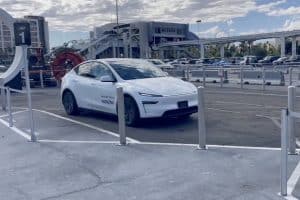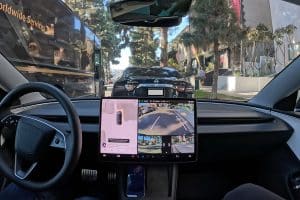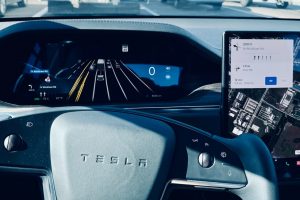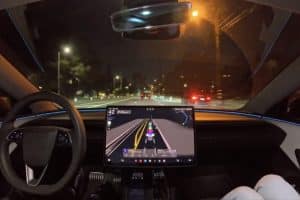- 🚗 Uber CEO doubts Tesla’s robotaxi execution.
- 📞 Customer service and vehicle owner skepticism cited as issues.
- 📅 Tesla plans to launch the robotaxi platform in October.
- 🚦 Peak ride-sharing times could clash with owner vehicle usage.
- 🧠 Society might not be ready for self-driving cars.
- 💼 Significant business changes needed for Tesla to succeed.
- 📊 Ride-sharing and vehicle production are very different industries.
- 🤝 Potential for Tesla to partner with ride-sharing services like Uber.
- 📱 Tesla has teased a mobile platform for robotaxi services.
- 🗺️ Tesla’s FSD advantage over other companies is lack of reliance on high-density mapping.
- 🕵️ Tesla’s FSD still requires supervision and testing continues.
Tesla’s Robotaxi Ambitions: A Bold Vision
Tesla has long been a frontrunner in the development of autonomous vehicle technology. The company’s CEO, Elon Musk, has repeatedly shared his vision of a future where Tesla owners can leverage their vehicles in a ride-sharing capacity, effectively turning their cars into money-making assets while they sit idle. The cornerstone of this vision is a fully autonomous robotaxi platform, slated for an initial launch in October.
Uber CEO’s Concerns
On a recent episode of the Logan Bartlett Show on YouTube, Dara Khosrowshahi shared his reservations regarding Tesla’s upcoming robotaxi venture. Here are some of the key points he raised:
1. Customer Service and Owner Skepticism
Khosrowshahi highlighted concerns about the customer service aspect of Tesla’s plan. “For Tesla’s robotaxi service to succeed, it will need to address significant customer service issues. How well will Tesla manage a fleet where a vehicle’s owner is absent? Owners may be skeptical about letting strangers into their cars, adding another layer of complexity.”
2. Peak Ride-Sharing Times
He pointed out a potential conflict of interest between car owners and ride-share passengers. “The times at which owners need their Teslas might coincide with peak ride-sharing times, challenging the availability of these vehicles for the robotaxi service.”
Is Society Ready for Self-Driving Cars?
One of the more profound points Khosrowshahi made touches upon societal readiness. Despite technological advancements, there is a question of whether people are mentally prepared to trust and accept self-driving vehicles.
“Logic would dictate that if robots are twice or three times as good at driving as humans, society benefits. However, I’m unsure if society is ready to accept that reality,” Khosrowshahi stated, reflecting a sentiment that many share.
Significant Business Changes Required
For Tesla’s robotaxi service to succeed, the company must undergo significant business changes. Khosrowshahi underscores how different ride-sharing businesses are from vehicle manufacturing:
Differences in Business Models
- Vehicle Production: Tesla specializes in building high-quality electric vehicles, which is a capital-intensive process.
- Ride-Sharing: On the other hand, ride-sharing operates on a high-volume, low-margin model. It deals with several million transactions daily, often generating revenue on a per-trip basis.
“Building a $20,000 or $50,000 piece of hardware from driving over 30 million transactions every day is just a very, very different business,” Khosrowshahi remarked.
Potential for Industry Partnerships
Considering these challenges, Khosrowshahi suggested that Tesla might benefit from partnerships with established ride-sharing platforms like Uber.
“It’s taken us 15 years and tens of billions of dollars of capital to build our ride-sharing platform. We could offer this instantly to a partner. Hopefully, Tesla will be one of those partners,” he added.
Tesla’s Existing Preparations
Tesla has been developing its Full Self-Driving (FSD) technology over several years, continuously enhancing it through real-world testing. Although the FSD is still under supervised operation, Tesla has teased its upcoming mobile platform for robotaxis, promising to reveal more soon.
Advantages Over Competitors
Musk has emphasized that Tesla’s FSD system, which relies on cameras and a neural network, offers a significant advantage over competitors like Waymo, who require high-density mapping of serviceable areas. This feature could allow Tesla’s FSD to adapt and operate in a broader range of environments.
Conclusion: A Complex Path Ahead
Tesla’s journey towards a fully autonomous robotaxi service is fraught with challenges, both technical and societal. While the vision is undeniably revolutionary, the execution will need to overcome hurdles such as customer service, societal readiness, and significant business model adaptations. With industry heavyweights skeptical yet hopeful for potential partnerships, the future of robotaxi services remains a compelling narrative to follow.





